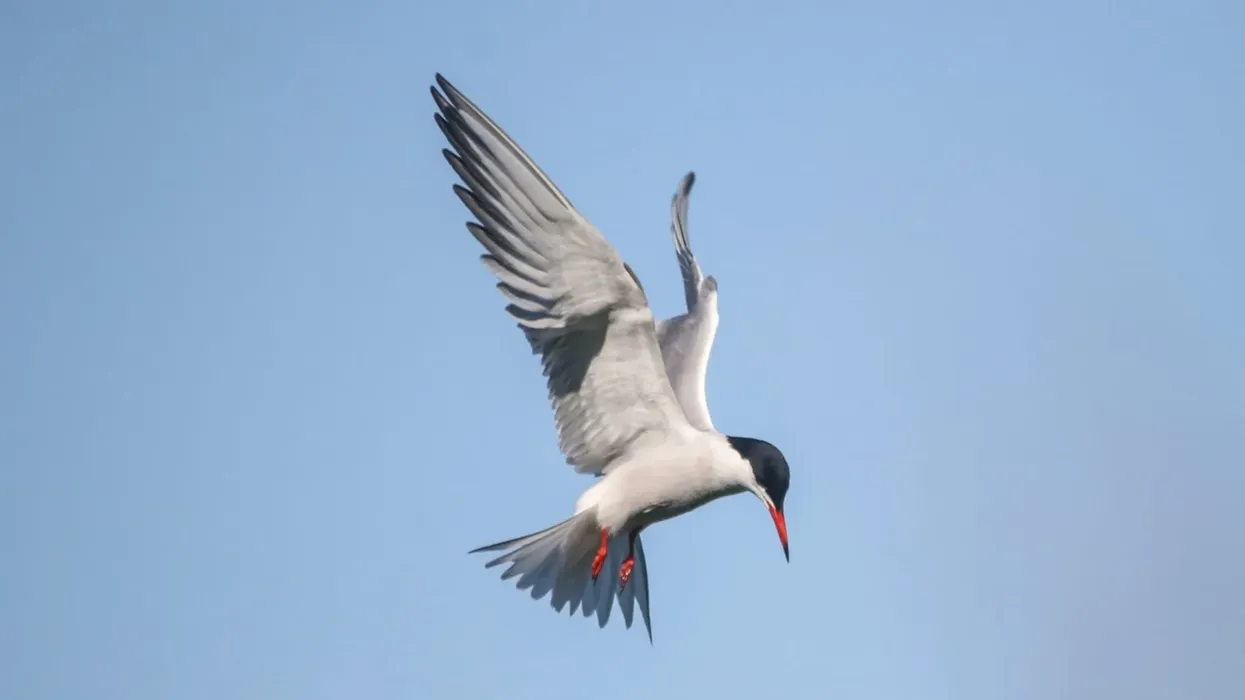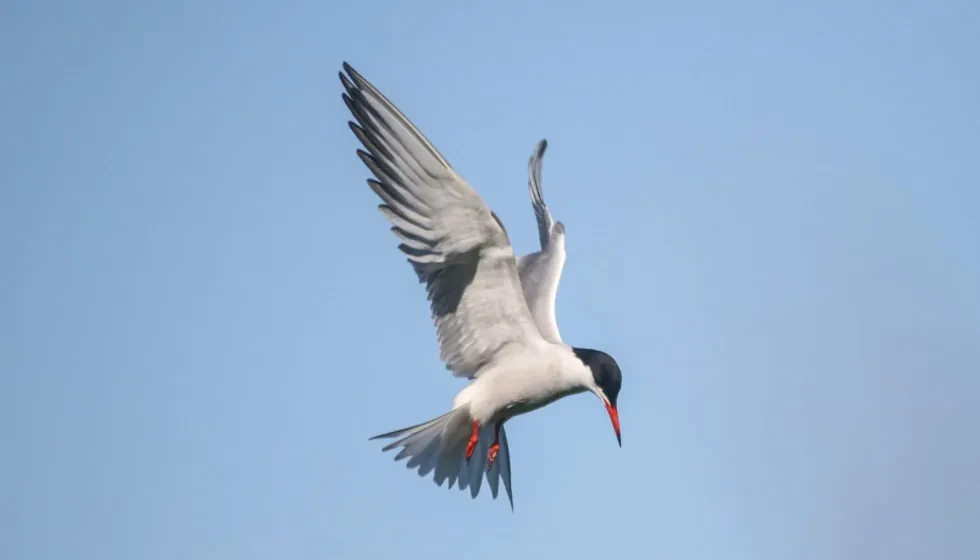The common tern is an attractive and fascinating bird of the wild. They are among the birds whose behavior will make you appreciate nature and its wonders. This bird is capable of filtering out most of the salt from seawater for all its drinking needs, and it can do all that while flying.
The common tern is a medium-sized bird that can be found around open oceans, beaches, and big lakes. Adults have black heads with light grey bodies.
The common tern (Sterna hirundo) belongs to the Laridae family of seabirds. This bird breeds in temperate and subarctic regions of Europe, Asia, and North America and has a circumpolar population distribution.
This migratory bird spends the winter in tropical and subtropical coastal areas.
The common tern has basic plumage in dark grey (upper parts), white to very light grey underparts, a black cap, orange-red wings, and a short pointed bill that distinguishes adults from juvenile common terns. Their bill can be mainly red with a black tip or entirely black, depending on the subspecies.
The partly sympatric Arctic tern is one of many related species that can be distinguished by plumage detail like the leg and bill color or vocalizations. The non-breeding Forster's tern (similar species) has a black ear patch, distinguishing it from breeding Forster's tern.
With a paler skull, it is somewhat longer-billed and shorter-tailed than the Arctic tern. They have a graceful, buoyant flight. A common tern, in flight, sometimes floats above water before diving for a small fish.
They make a lot of noise while they're in a group and breed in colonies. The most widespread tern species occurring on the inland ground is the common tern.
If you like reading this, then you must also give a read top puffin and verdin facts.
Common Tern Interesting Facts
What type of animal is a common tern?
Common tern (Sterna hirundo) birds are a type of North American bird.
What class of animal does a common tern belong to?
Common terns belong to the Aves class.
How many common terns are there in the world?
The common tern population is around 1,600,000–4,600,000. The largest population is in Asia, with about 500,000 pairs and a population of 140,000 pairs of these birds is breeding in Europe, while the North American populations constitute around 80,000 pairs of this bird.
Where does a common tern live?
Populations of common terns can be found near the ocean, such as the Atlantic coast of North America, beaches of New York, and parts of Europe.
What is a common tern's habitat?
Almost all common terns live in colonies known as ternaries. The colonies are often located on the shores of major lakes, but they can also be found along ocean coasts. The birds must also be able to communicate with the rest of the colony visually and vocally from their nest.
A common tern's nest is built among cliffs and rocks. Coastal and inland waters have a diverse variety of marine environments and wildlife in the summer. Winters are spent mostly around the coasts in warm subtropical or tropical waters.
Who do common terns live with?
Their population is in the range of 1,000-2,000 pairs of birds live in colonies known as ternary. Sometimes their populations in their range exceed 20,000 birds.
How long does a common tern live?
Common tern lifespan ranges between 9-10 years.
How do they reproduce?
Male terns develop their habitat at the colony during courtship, which starts in April, before starting 'courtship feeding' in which males carry fish to females as a means of courting them. The male tern posturing is supplemented by the two terns circling each other during premating displays.
Until actual copulation, the males ride the females for one or two minutes at a time. During and immediately after copulation, common terns are notorious for flapping their wings wildly. Monogamy is the standard for common terns.
Since migrating to their breeding ground shortly after the start of spring, common terns go on to find a place for nesting in early to mid-summer. It's unusual for a couple to have more than one clutch of eggs every season.
After the eggs hatch, one of the birds remains at the nest at all times. The female is mostly the one to watch the nest.
Since their chicks are more likely to be injured or killed by predators after they begin to walk on their own, the family becomes very aggressive. The family builds their nest among cliffs and rocks.
Shells and ashes, as well as dead plants, are used to build the nest. The clutch size of eggs is in the range of 0ne to three, eggs are colored pale blue or olive, and the eggs hatch in three to four weeks.
In 27 -30 days, the young fledge. Common tern chicks can fly after a month, but it takes three years for them to achieve sexual maturity.
What is their conservation status?
The conservation status of this bird species, based on recent surveys, is Least Concern. Common tern conservation history is unknown.
Common Tern Fun Facts
What do common terns look like?
A common tern's black cap and red bill are the most distinguished features. The tail of these North American birds is forked, and the tail feathers are longer than those of other tern species.
The wing has the same width throughout. The underparts of common terns are much paler than the upper parts, particularly in adult terns, and the body is whitish-gray. In most cases, the female is significantly smaller than the male.
When the tern flies, its bill is normally pointing downward. Other distinguishing features include a robust head and neck and unusually long legs, which set them apart from other terns such as Arctic terns.
Common tern's winter plumage is molted after the breeding season. They have a dark carpel bar with an orange bill base. The bill itself is darker than usual, and its mantle is reddish.

How cute are they?
Common terns are cute, especially because of the attractive common tern bill, which is red with a tint of black, and it also has majestic white feathers.
How do they communicate?
Common terns are very active vocal communicators within their range. They make a 'kee-arr' call when threatened. They make a 'kip' sound when feeding and a shrill during a territorial breach. They are also heard making various sounds during mating season.
How big is a common tern?
The length of these terns is in the range of 29.5-31.5 in (75-80 cm), and their height is in the range of 12.2-15.0 in (31-38 cm). Their size is about six times the size of a hummingbird.
How fast can a common tern fly?
Terns can fly at an average speed of 30 mph (48 kph).
How much does a common tern weigh?
The weight of common tern species is 3.3-7 oz (93-200 g).
What are the male and female names of the species?
There are no special male and female names for this species.
What would you call a baby common tern?
Baby common tern birds don't have specific names but can be referred to as chicks.
What do they eat?
Small fish is normally the only food that common terns eat. When food is plentiful, the terns usually always eat more fish than they need.
Occasionally, common terns capture fish that are too large for them to eat. This, along with their proclivity for catching as many as they can, even though it isn't required, explains why terns' nesting grounds are always littered with fish.
Insects, annelids, and echinoderms, in addition to fish, may be eaten by terns at the start of the breeding season.
The tern's diet is much more restricted during the later stages of the breeding season. However, their main threats are red fox.
Are they aggressive?
They are not aggressive species, but they do get aggressive when their chicks start to walk to protect them from predators.
Would they make a good pet?
They will not be good pets as their habitat is open ground and water, and keeping them as pets restrict that.
Did you know...
The common tern mating ritual consists of 'courtship feeding' in which males carry fish to females as a means of courting them.
Common tern vs Caspian tern: Caspian terns are the largest terns having a large beak and a shallowly forked tail, while common terns are smaller in size and have a small beak with a deeply forked tail.
Forster's terns have a white belly with an orange beak, while common terns have grey breasts with red beaks.
The Roseate tern has a shorter tail and is darker overall than the greyish color of common tern.
Common tern breeds in Europe, Asia, and North America. After the breeding season, common tern migration is from the south to spend the winter around the tropics and southern hemisphere's coasts and islands, including Africa and South America.
The millinery trade's use of tern feathers and wings was the primary cause of the significant population decline in common terns.
Terns show strange behavior in which one or all of the North American birds unexpectedly take off from the ground and fly low over the sea, either to ward off predators or for no particular reason.
Common terns reach the UK during April after wintering and will stick around till later August or September.
Climate change may be a direct cause for the decline of the common tern range as it can reduce upwards of 40% as the temperature increases up to 3℃.
How many common terns are in a colony?
A colony of common terns, also known as a ternary, consists of 2,000 pairs, but sometimes colonies have been seen to have 20,000 pairs.
How has common tern's memory adapted?
With so many nests in one colony, you can imagine how hard it would be for terns to remember where their own nest is. However, research has shown that these terns can locate their eggs even though the nest has been buried and no trace of it remains.
In such an exposed area, where losing a nest is possible, this is a natural adaptation.
Here at Kidadl, we have carefully created lots of interesting family-friendly animal facts for everyone to discover! Learn more about some other birds, including these Galapagos penguin facts, or golden-crowned kinglet facts.
You can even occupy yourself at home by coloring in one of our common tern coloring pages.









